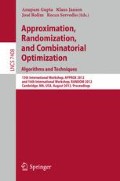Abstract
Aiming to unify known results about clustering mixtures of distributions under separation conditions, Kumar and Kannan [1] introduced a deterministic condition for clustering datasets. They showed that this single deterministic condition encompasses many previously studied clustering assumptions. More specifically, their proximity condition requires that in the target k-clustering, the projection of a point x onto the line joining its cluster center μ and some other center μ′, is a large additive factor closer to μ than to μ′. This additive factor can be roughly described as k times the spectral norm of the matrix representing the differences between the given (known) dataset and the means of the (unknown) target clustering. Clearly, the proximity condition implies center separation – the distance between any two centers must be as large as the above mentioned bound.
In this paper we improve upon the work of Kumar and Kannan [1] along several axes. First, we weaken the center separation bound by a factor of \(\sqrt{k}\), and secondly we weaken the proximity condition by a factor of k (in other words, the revised separation condition is independent of k). Using these weaker bounds we still achieve the same guarantees when all points satisfy the proximity condition. Under the same weaker bounds, we achieve even better guarantees when only (1 − ε)-fraction of the points satisfy the condition. Specifically, we correctly cluster all but a (ε + O(1/c 4))-fraction of the points, compared to O(k 2 ε)-fraction of [1], which is meaningful even in the particular setting when ε is a constant and k = ω(1). Most importantly, we greatly simplify the analysis of Kumar and Kannan. In fact, in the bulk of our analysis we ignore the proximity condition and use only center separation, along with the simple triangle and Markov inequalities. Yet these basic tools suffice to produce a clustering which (i) is correct on all but a constant fraction of the points, (ii) has k-means cost comparable to the k-means cost of the target clustering, and (iii) has centers very close to the target centers.
Our improved separation condition allows us to match the results of the Planted Partition Model of McSherry [2], improve upon the results of Ostrovsky et al [3], and improve separation results for mixture of Gaussian models in a particular setting.
Access this chapter
Tax calculation will be finalised at checkout
Purchases are for personal use only
Preview
Unable to display preview. Download preview PDF.
References
Kumar, A., Kannan, R.: Clustering with spectral norm and the k-means algorithm. In: FOCS (2010)
McSherry, F.: Spectral partitioning of random graphs. In: FOCS (2001)
Ostrovsky, R., Rabani, Y., Schulman, L.J., Swamy, C.: The effectiveness of lloyd-type methods for the k-means problem. In: FOCS, pp. 165–176 (2006)
Dasgupta, S.: Learning mixtures of gaussians. In: FOCS (1999)
Dasgupta, S., Schulman, L.: A probabilistic analysis of em for mixtures of separated, spherical gaussians. J. Mach. Learn. Res. (2007)
Sanjeev, A., Kannan, R.: Learning mixtures of arbitrary gaussians. In: STOC (2001)
Vempala, S., Wang, G.: A spectral algorithm for learning mixtures of distributions. Journal of Computer and System Sciences (2002)
Achlioptas, D., McSherry, F.: On Spectral Learning of Mixtures of Distributions. In: Auer, P., Meir, R. (eds.) COLT 2005. LNCS (LNAI), vol. 3559, pp. 458–469. Springer, Heidelberg (2005)
Chaudhuri, K., Rao, S.: Learning mixtures of product distributions using correlations and independence. In: COLT (2008)
Kannan, R., Salmasian, H., Vempala, S.: The spectral method for general mixture models. SIAM J. Comput. (2008)
Dasgupta, A., Hopcroft, J., Kannan, R., Mitra, P.: Spectral clustering with limited independence. In: SODA (2007)
Brubaker, S.C., Vempala, S.: Isotropic pca and affine-invariant clustering. In: FOCS (2008)
Coja-Oghlan, A.: Graph partitioning via adaptive spectral techniques. Comb. Probab. Comput. 19, 227–284 (2010)
Awasthi, P., Sheffet, O.: Improved spectral-norm bounds for clustering, full version (2012), http://arxiv.org/abs/1206.3204
Kumar, A., Sabharwal, Y., Sen, S.: A simple linear time (1 + ε)-approximation algorithm for k-means clustering in any dimensions. In: FOCS (2004)
Cohen, W.W., Richman, J.: Learning to match and cluster large high-dimensional data sets for data integration. In: KDD, pp. 475–480 (2002)
Murzin, A.G., Brenner, S.E., Hubbard, T., Chothia, C.: Scop: a structural classification of proteins database for the investigation of sequences and structures. Journal of Molecular Biology 247(4), 536–540 (1995)
Kannan, R., Vempala, S.: Spectral algorithms. Found. Trends Theor. Comput. Sci. (March 2009)
Golub, G.H., Van Loan, C.F.: Matrix computations, 3rd edn. Johns Hopkins University Press, Baltimore (1996)
Chaudhuri, K., Rao, S.: Beyond gaussians: Spectral methods for learning mixtures of heavy-tailed distributions. In: COLT (2008)
Kalai, A.T., Moitra, A., Valiant, G.: Efficiently learning mixtures of two gaussians. In: STOC 2010, pp. 553–562 (2010)
Moitra, A., Valiant, G.: Settling the polynomial learnability of mixtures of gaussians. In: FOCS 2010 (2010)
Belkin, M., Sinha, K.: Polynomial learning of distribution families. Computing Research Repository abs/1004.4, 103–112 (2010)
Schulman, L.J.: Clustering for edge-cost minimization (extended abstract). In: STOC, pp. 547–555 (2000)
Balcan, M.F., Blum, A., Gupta, A.: Approximate clustering without the approximation. In: SODA, pp. 1068–1077 (2009)
Author information
Authors and Affiliations
Editor information
Editors and Affiliations
Rights and permissions
Copyright information
© 2012 Springer-Verlag Berlin Heidelberg
About this paper
Cite this paper
Awasthi, P., Sheffet, O. (2012). Improved Spectral-Norm Bounds for Clustering. In: Gupta, A., Jansen, K., Rolim, J., Servedio, R. (eds) Approximation, Randomization, and Combinatorial Optimization. Algorithms and Techniques. APPROX RANDOM 2012 2012. Lecture Notes in Computer Science, vol 7408. Springer, Berlin, Heidelberg. https://doi.org/10.1007/978-3-642-32512-0_4
Download citation
DOI: https://doi.org/10.1007/978-3-642-32512-0_4
Publisher Name: Springer, Berlin, Heidelberg
Print ISBN: 978-3-642-32511-3
Online ISBN: 978-3-642-32512-0
eBook Packages: Computer ScienceComputer Science (R0)

